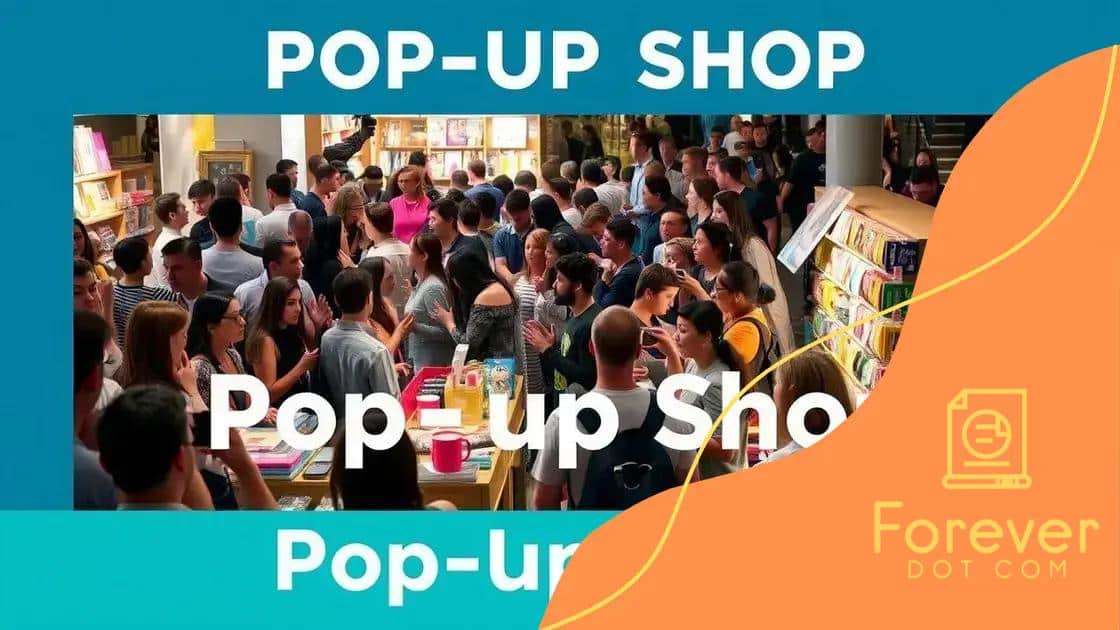How pop-up shops are reshaping fashion retail events

Pop-up shops are temporary retail spaces that boost brand visibility and customer engagement, offering unique shopping experiences while presenting logistical challenges such as location selection and inventory management.
How pop-up shops are reshaping fashion retail events is a trend that’s capturing attention in the industry. These temporary venues not only create buzz but also offer exclusive experiences that can draw in consumers. What makes them so effective and why should you pay attention?
The rise of pop-up shops in fashion retail
The rise of pop-up shops in fashion retail is a phenomenon that reflects changing consumer behavior. In recent years, brands have embraced these temporary retail spaces as a way to connect directly with customers and create unique shopping experiences.
More than just a trend, these shops provide a fresh venue for brands. They pop up in various locations, from bustling city streets to trendy neighborhoods. This strategy not only generates excitement but also fosters community engagement.
Benefits of Pop-Up Shops
Pop-up shops offer numerous advantages for fashion retailers looking to enhance their reach.
- They allow brands to test new markets without a long-term commitment.
- These shops create a sense of urgency, driving quick sales.
- They offer opportunities for product launches and exclusive events.
- Networking with local influencers enhances visibility.
By setting up in unexpected places, brands can attract curious shoppers. This creativity encompasses not just the product offerings, but also the overall shopping experience. Customers are often treated to immersive environments that reflect the brand ethos.
Drawing in the Crowd
Another key factor in the success of pop-up retail is the role of social media. Brands use these platforms to create buzz around their events.
Engaging posts and stories entice followers to visit these unique shops. Hashtags and geotags increase awareness and reach new audiences quickly. This digital engagement often translates to real-life foot traffic.
As fashion continues to evolve, pop-up shops are likely to remain a crucial part of retail strategy. They blend creativity with marketing savvy, enabling traditional brands to adapt to modern shopping habits.
How pop-up shops enhance customer experience
Pop-up shops are changing the way customers interact with brands. These temporary spaces not only offer products but also create memorable experiences that draw shoppers in. When a customer steps into a pop-up shop, they often feel the excitement of something new and exclusive.
One key way that pop-up shops enhance customer experience is through unique designs. Often, these shops are visually stunning, curated to reflect the brand’s identity. Each detail is crafted to engage the senses, making every visit a visual treat.
Interactive Elements
Moreover, many pop-up stores include interactive elements that encourage customer participation. This engagement can take various forms:
- Workshops where customers can learn about products.
- Photo opportunities that encourage sharing on social media.
- Live demonstrations of products.
- Exclusive merchandise that is only available on-site.
Such activities create a dynamic atmosphere that fosters connection. Shoppers feel like they are part of something special rather than just purchasing items. This sense of involvement is essential in today’s retail environment.
Personalization
Another advantage of pop-up retail is the opportunity for personalization. Many brands use these events to gather insights about their customers. Staff can engage directly with visitors, asking questions and gathering feedback.
This immediate interaction allows brands to tailor their offerings based on customer preferences. The insights gained can guide future marketing efforts and product development. As a result, customers feel heard and valued, enhancing their overall experience.
Ultimately, pop-up shops create an environment where shopping feels more engaging and less transactional. Retailers can build relationships that go beyond the sale. As brands continue to innovate, the success of these shops proves that experiential retail is here to stay.
Impact of pop-up shops on brand visibility

The impact of pop-up shops on brand visibility is significant in today’s retail landscape. These short-term retail experiences attract attention and create buzz around a brand. Unlike traditional brick-and-mortar stores, pop-up shops can pop up unexpectedly, generating excitement and curiosity among consumers.
When brands utilize pop-up shops, they can showcase their products in unique ways. This distinctive approach often leads to increased media coverage and social media shares. As a result, a brand can reach new audiences that may not have been engaged otherwise.
Creating a Unique Brand Experience
By offering a tangible experience, these shops allow customers to interact with products and the brand itself.
- Live events and launches can create excitement.
- Custom installations enhance the shopping experience.
- Creative theming makes the brand more memorable.
- Exclusive items increase desirability.
This uniqueness draws in shoppers and creates lasting impressions. When customers associate positive experiences with a brand, they are more likely to share their encounters online.
Utilizing Social Media
Pop-up shops often serve as perfect opportunities for brands to leverage social media. The novelty of the event makes it highly shareable. Brands encourage visitors to post their experiences online, using specific hashtags.
This user-generated content can significantly boost a brand’s online presence. As more customers share their experiences, the brand gains visibility and credibility.
In a world where attention spans are short, the excitement of a pop-up shop can create a lasting impact that positions a brand favorably in consumers’ minds. As brands continue to evolve, embracing pop-up experiences could be key to enhancing visibility in a competitive market.
The role of social media in pop-up shops
Social media plays a crucial role in the success of pop-up shops. These platforms help brands create buzz and excitement before, during, and after the events. With millions of people scrolling through their feeds, social media serves as an essential tool to reach a wider audience.
Brands often use social media to announce their pop-up events. Creative posts and countdowns can create anticipation among followers. Engaging visuals attract attention, prompting people to share and discuss the upcoming shop. This sharing creates a ripple effect, leading to more visibility.
Engaging Content
During the event, brands can use live videos to showcase the atmosphere and products available. This real-time interaction engages those who couldn’t attend, making them feel included.
- Behind-the-scenes content deepens the connection with followers.
- Live Q&A sessions can answer customer inquiries directly.
- Encouraging attendees to tag the brand in their posts extends reach.
- Contests and giveaways can drive engagement and traffic.
By sharing customer experiences, brands gain authentic testimonials. Posts showing happy customers interacting within the pop-up shop can be powerful in attracting new followers and potential buyers. This visibility can convert casual shoppers into loyal customers.
Post-Event Follow-Up
After the event, social media remains vital for maintaining momentum. Brands can share highlights, such as customer interactions and best-selling items. This not only reminds attendees of their experience but also showcases the event to those who missed it.
Additionally, creating hashtags specific to the event can lead to user-generated content. When customers share their own photos with these hashtags, it amplifies the brand’s message. Each share helps the brand reach new audiences, feeding into the continuous cycle of engagement and visibility.
In today’s digital age, the relationship between social media and pop-up shops is undeniable. Brands that leverage these platforms effectively can maximize their exposure and build lasting customer connections.
Challenges of managing pop-up retail events
Managing pop-up retail events comes with its own set of challenges. While these unique shopping experiences can boost brand visibility, they also require careful planning and execution. From logistics to customer engagement, there are many obstacles that brands must navigate.
One major challenge is location selection. Finding the perfect spot can significantly impact foot traffic and overall success. A high-traffic area might attract more customers, but it can also come with higher costs and competition.
Logistical Concerns
Additionally, logistics play a vital role in the success of these events. Brands must ensure they have enough inventory to meet demand without overstocking. Setting up the shop requires coordination with various vendors, from display suppliers to technology providers.
- Shipping and transporting products can become complicated and costly.
- Setting up an appealing layout requires time and design skills.
- Ensuring the venue is fully equipped with necessary utilities is crucial.
- Obtaining necessary permits and licenses adds to planning complexity.
Another challenge is time management. Pop-up shops often operate on tight schedules, making it essential to stay organized. Delays in setup or inventory delivery can affect the entire event. Brands need to have contingency plans in place for any unforeseen circumstances.
Customer Engagement
Engaging customers can also be tricky. While pop-up shops aim to create memorable experiences, brands must actively encourage participation. Failing to connect with customers can result in missed opportunities for building relationships.
Staff training is critical to ensure that employees are knowledgeable and friendly. Engaging with shoppers through interactive displays or live demonstrations can enhance their experience. Without effective customer interaction, the event may not leave a lasting impression.
Despite the challenges of managing pop-up retail events, the potential benefits often outweigh the difficulties. Brands that can navigate these obstacles and execute successful pop-up shops are likely to see improved brand loyalty and increased sales.
FAQ – Frequently Asked Questions about Pop-Up Shops
What are pop-up shops?
Pop-up shops are temporary retail spaces that allow brands to showcase products and engage with customers in unique locations for a limited time.
How can I successfully manage a pop-up shop?
Successful management involves careful planning of logistics, selecting the right location, and ensuring inventory meets customer demand.
What role does social media play in pop-up shops?
Social media helps create buzz around pop-up events, allowing brands to reach a wider audience and engage customers through posts, stories, and live videos.
What challenges do brands face when organizing pop-up shops?
Brands often face logistical challenges, including inventory management, securing permits, and creating engaging customer experiences.






